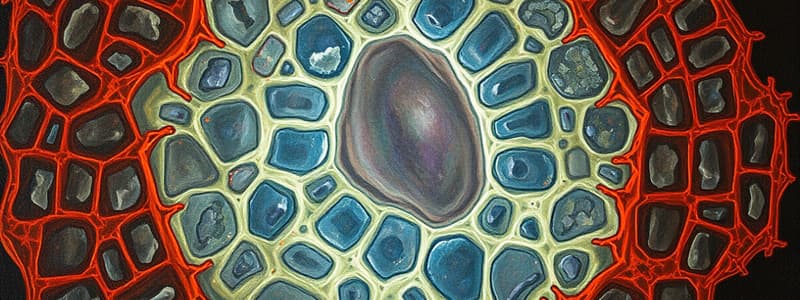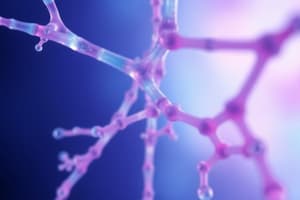Podcast
Questions and Answers
What is the fundamental component of cells as stated by cell theory?
What is the fundamental component of cells as stated by cell theory?
- Nucleus
- Chromosome
- Organelle
- Cell (correct)
Which of the following is NOT a component found within the cytoplasm?
Which of the following is NOT a component found within the cytoplasm?
- Nucleic acids
- Plasma membrane (correct)
- Glucose
- Ribosomes
What provides the semi-solid consistency of the cytoplasm?
What provides the semi-solid consistency of the cytoplasm?
- Water alone
- Organic molecules primarily
- Dissolved ions
- Proteins (correct)
How is the structure of the plasma membrane often described?
How is the structure of the plasma membrane often described?
Which process predominantly occurs in the cytoplasm of a cell?
Which process predominantly occurs in the cytoplasm of a cell?
What is the main structural composition of most bacterial and eukaryotic plasma membranes?
What is the main structural composition of most bacterial and eukaryotic plasma membranes?
How do archaeal membrane phospholipids differ from those in bacterial and eukaryotic membranes?
How do archaeal membrane phospholipids differ from those in bacterial and eukaryotic membranes?
What role do glycoproteins and glycolipids play in the plasma membrane?
What role do glycoproteins and glycolipids play in the plasma membrane?
What is a key difference between prokaryotic and eukaryotic chromosomes?
What is a key difference between prokaryotic and eukaryotic chromosomes?
What is the function of plasmids in cells?
What is the function of plasmids in cells?
In which types of organisms have plasmids been found?
In which types of organisms have plasmids been found?
What structural characteristic distinguishes eukaryotic ribosomes from prokaryotic ribosomes?
What structural characteristic distinguishes eukaryotic ribosomes from prokaryotic ribosomes?
Which statement about ribosomes is incorrect?
Which statement about ribosomes is incorrect?
What do prokaryotic cells lack compared to eukaryotic cells?
What do prokaryotic cells lack compared to eukaryotic cells?
Why are ribosomes particularly abundant in certain cells like those in the pancreas?
Why are ribosomes particularly abundant in certain cells like those in the pancreas?
Flashcards are hidden until you start studying
Study Notes
Cell Theory and Components
- Cell theory emphasizes that the cell is the basic unit of life.
- Cells differ in size, shape, structure, and function.
- Fundamental components of all cells:
- Cytoplasm: gel-like substance for growth.
- Plasma membrane: encloses the cytoplasm.
- Chromosomes: genetic blueprints inside the cytoplasm.
- Ribosomes: structures for protein synthesis.
Cytoplasm
- Surrounds the plasma membrane; composed of 70-80% water.
- Contains nutrients, enzymes, and suspended organic molecules.
- Includes glucose, amino acids, fatty acids, and nucleic acids.
- Dissolved ions like sodium and potassium present.
- Site for metabolic reactions, including protein synthesis.
Plasma Membrane
- All cells possess a plasma membrane with selective permeability.
- Described by the fluid mosaic model, indicating mobility of membrane components.
- Composed of a bilayer of phospholipids and diverse proteins.
- Eukaryotic membranes contain sterols (e.g., cholesterol) for fluidity.
- Archaeal membranes differ, featuring ether linkages and branched phospholipid chains.
- Surface proteins aid in cell communication and environmental sensing.
- Glycoproteins and glycolipids allow for interaction with the external environment.
DNA
- Double-stranded DNA organized into chromosomes carries essential life information.
- Prokaryotic chromosomes: circular, haploid, and lack a nuclear membrane.
- In humans, there are 46 chromosomes; fruit flies have 8.
- Chromosomes are visible during cell division; otherwise, they exist as chromatin (unwound form).
- Extrachromosomal DNA (plasmids) carry advantageous traits, such as antibiotic resistance.
- Plasmids are primarily found in bacteria, but can also exist in archaea and eukaryotes.
Ribosomes
- All cellular life utilizes ribosomes for protein synthesis.
- Ribosomes consist of proteins and ribosomal RNA.
- Differences in ribosomes between domains (bacterial, archaeal, eukaryotic):
- Bacterial and archaeal ribosomes contain distinct proteins and rRNA; archaeal are closer to eukaryotic ribosomes.
- Eukaryotic ribosomes are 80S with a small and large subunit.
- Ribosomes are abundant in cells with high protein synthesis needs, like pancreatic cells producing digestive enzymes.
Cell Types: Prokaryotic vs. Eukaryotic
- Prokaryotic cells:
- Lack a nucleus and membrane-bound organelles.
- Usually contain a single, circular chromosome in a nucleoid.
- Eukaryotic cells:
- Have a nucleus surrounded by a nuclear membrane.
- Contain multiple linear chromosomes and various membrane-bound organelles.
Studying That Suits You
Use AI to generate personalized quizzes and flashcards to suit your learning preferences.




